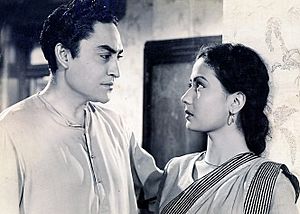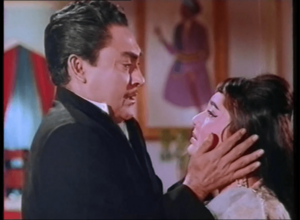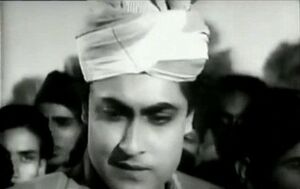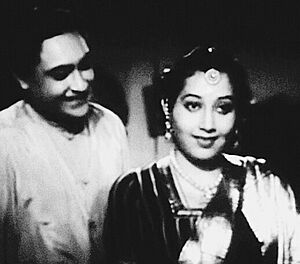Ashok Kumar facts for kids
Quick facts for kids
Ashok Kumar
|
|
|---|---|

Kumar in the film Jhoola (1941)
|
|
| Born |
Kumudlal Ganguly
13 October 1911 |
| Died | 10 December 2001 (aged 90) Mumbai, Maharashtra, India
|
| Other names | Sanjay Ashok Kumar Dadamoni |
| Occupation | Actor, painter, singer |
| Years active | 1934–1997 |
| Spouse(s) |
Shobha Devi (m. 1935)
|
| Children | 4, including Preeti Ganguly |
| Relatives | See Ganguly family See Mukherjee-Samarth family |
| Awards |
|
| Honours |
|
Kumudlal Ganguly (born October 13, 1911 – died December 10, 2001), known by his stage name Ashok Kumar, was a very famous Indian actor. People also called him Dadamoni. He became a huge star in Indian cinema. He was part of the well-known Ganguly family of actors and filmmakers.
In 1988, he received the Dadasaheb Phalke Award. This is the highest national award for film artists in India. He also got the Padma Bhushan in 1999 for his great work in Indian cinema.
Contents
About His Life
Ashok Kumar was born Kumudlal Ganguly in Bhagalpur, which was then part of British India. His family was a Bengali Hindu Brahmin family. His father, Kunjlal Ganguly, was a lawyer, and his mother, Gouri Devi, was a homemaker.
Kumudlal was the oldest of four children. His sister, Sati Devi, married Sashadhar Mukherjee at a young age. She became part of a big film family. His younger brother, Kalyan, later became the actor Anoop Kumar. The youngest brother, Abhas, became the super-successful singer Kishore Kumar. Kumudlal lived longer than all his siblings. He even stopped celebrating his birthday after Kishore, his youngest brother, passed away on his birthday in 1987.
When he was still a teenager, Kumudlal married Shobha. Their marriage was arranged by their parents, as was common in India. They had a happy marriage and raised their children with traditional values. They had one son, Aroop Ganguly, and three daughters: Bharati Patel, Rupa Verma, and Preeti Ganguly. Aroop Kumar Ganguly acted in one film but then chose a career in business. His youngest daughter, Preeti Ganguly, became a comedienne in Hindi films.
Ashok Kumar studied at Presidency College in Kolkata. He was supposed to become a lawyer. But he was more interested in cinema and wanted to work behind the scenes as a technician.
His Film Career
Starting Out (1936–1942)
Kumudlal's father wanted him to be a lawyer. But Kumudlal failed his law exams. To avoid trouble at home, he went to live with his sister in Mumbai. His brother-in-law, Sashadhar Mukherjee, worked at Bombay Talkies, a big film studio. Kumudlal asked for a job there to earn some money.
He got a job as a laboratory assistant in the early 1930s. He liked the work and was good at it. He convinced his father to let him stop studying law and work in films instead. This is how Ashok Kumar started his amazing film journey, not as an actor, but as a lab assistant!
Ashok Kumar worked as a lab assistant for about five years. His acting career began by accident. In 1936, the main actor of the film Jeevan Naiya left the movie set. The owner of Bombay Talkies, Himanshu Rai, asked Kumudlal to take his place. The director thought Kumudlal wasn't handsome enough to be an actor. But Kumudlal took the role and was given the screen name Ashok Kumar.
Ashok Kumar wasn't keen on acting at first. But his next film, Achhut Kanya, with Devika Rani, was a huge hit in 1936. This movie was about a Brahmin boy falling in love with a girl from the "untouchables" community. Achhut Kanya made Ashok Kumar and Devika Rani a very popular on-screen couple.
They made many more films together, like Janmabhoomi (1936) and Vachan (1938). Their last film together was Anjaan (1941). Devika Rani was a bigger star, and Ashok Kumar often worked in her shadow.
He started to become famous on his own when he worked with actress Leela Chitnis. Their films like Kangan (1939), Bandhan (1940), and Azad (1940) were very successful. Jhoola (1941) made him one of the most reliable actors of that time.
Becoming a Star (1943–1950)
In 1943, Ashok Kumar starred in the film Kismet. He played the first "anti-hero" in Indian Cinema. This film broke all box office records, earning over 1 crore (a very large sum of money at the time). Kismet made Ashok Kumar the first superstar of Indian cinema. He was so popular that people would mob him wherever he went, stopping traffic!
After Kismet, Ashok Kumar continued to have many hit movies. These included Chal Chal Re Naujawan (1944), Mahal (1949), and Mashaal (1950).
He also produced films for Bombay Talkies. He helped start the careers of actors like Dev Anand and Pran in Ziddi (1948). He also helped launch Raj Kapoor in Neelkamal (1947) and Madhubala in Mahal.
Later Roles (1950s)
In the 1950s, Ashok Kumar started taking on more grown-up roles. One exception was the 1958 film Howrah Bridge, where he starred with Madhubala. Even with new, younger stars appearing, Ashok Kumar remained popular. He had hits like Afsana (1951), Parineeta (1953), and Howrah Bridge (1958). His film Deedar (1951) was also very successful.

Ashok Kumar often worked with actress Nalini Jaywant in the 1950s. He also made about 17 films with Meena Kumari over twenty years, including Pakeezah (1972). In the mid-1950s, he often played cool, cigarette-smoking criminals or police officers in detective-style films.
Character Roles (1960s and 1970s)
By the 1960s, Ashok Kumar began playing "character roles." These were roles like a parent, uncle, or grandparent. He was careful not to play the same type of role too often. He played a judge in Kanoon (1960), an old freedom fighter in Bandini (1963), and a criminal in Victoria no.203 (1971). He showed he could play many different kinds of characters.

Ashok Kumar played important roles in many famous movies in the 1960s and 1970s. These included Jewel Thief (1967), Aashirwad (1968), and Pakeezah (1972). For Aashirwad, he won both a Filmfare Award and a National Award in 1969.
Ashok Kumar and actor Pran were very good friends. They acted in 27 films together, and 20 of them were big hits. Some of these were Purab Aur Pashchim, Victoria 203, and Chori Mera Kaam.
He also worked with actors like Shashi Kapoor and Rajesh Khanna in many films in the 1970s and 1980s. He often played a main supporting role in their movies.
His Last Years
Ashok Kumar acted in fewer films in the 1980s and 1990s. He also appeared on television. He famously hosted Hum Log, which was India's first soap opera. He also played the main character in Bahadur Shah Zafar.
His last film role was in the 1997 movie Aankhon Mein Tum Ho. Besides acting, he loved to paint and practiced homeopathy, a type of medicine. He was known for finding amazing cures. In total, he starred in over 275 films. He also performed in more than 30 Bengali plays.
His Passing
Ashok Kumar passed away at the age of 90 in Mumbai on December 10, 2001. He died from heart failure at his home in Chembur. The Prime Minister of India at that time, Atal Bihari Vajpayee, said Ashok Kumar was "an inspiration... for many generations of aspiring actors."
His Impact
Ashok Kumar was a groundbreaking actor. He brought a natural style of acting to Hindi cinema. He was the first superstar of Hindi cinema. He was also the first lead actor to play an "anti-hero" (a character who is not completely good). He also showed how an actor could change their roles and have a long, successful career playing different types of characters.
Ashok Kumar also helped many people become successful in Indian cinema. As a producer at Bombay Talkies, he gave Dev Anand his first big chance in Ziddi (1948). This film also helped establish Pran as a leading villain. The 1949 film Mahal, starring Ashok Kumar, helped launch the career of Madhubala, a top actress of the 1950s. A song from Mahal, "Aayega Aanewala", also made a then-unknown singer named Lata Mangeshkar very famous.
Off-screen, Ashok Kumar helped B.R. Chopra, who later became a respected filmmaker, direct his first film, Afsana (1951). He also mentored his assistant at Bombay Talkies, Hrishikesh Mukherjee, who became one of the greatest directors in Hindi cinema. Ashok Kumar was also a lucky charm for young director Shakti Samanta in the late 1950s. Their films like Inspector (1956) and Howrah Bridge (1958) helped Samanta become a successful director.
Ashok Kumar also opened doors for his younger brothers, Kalyan (Anoop) and Kishore Kumar. Anoop is remembered for his role in Chalti Ka Naam Gaadi (1958). Kishore went on to become an incredibly popular singer. Many people today consider Kishore the most famous of the brothers.
Ashok Kumar and his brother Anoop also acted together in the 1990 TV show Bheem Bhawani.
The unique way Ashok Kumar acted and his mannerisms in his later career are still popular with mimicry artists today.
Awards and Recognition
- 1959 – Sangeet Natak Akademi Award
- 1962 – Filmfare Award for Best Actor, Rakhi
- 1962 – Padma Shri by the Government of India
- 1963 – Nominated – Filmfare Award for Best Actor, Gumrah
- 1963 – Bengal Film Journalists' Association – Best Actor Award (Hindi), Gumrah
- 1966 – Filmfare Award for Best Supporting Actor, Afsana
- 1967 – Nominated – Filmfare Award for Best Supporting Actor, Meherban
- 1969 – Filmfare Award for Best Actor, Aashirwaad
- 1969 – National Film Awards for Best Actor, Aashirwaad
- 1969 – Bengal Film Journalists' Association Award for Best Actor (Hindi), Aashirwaad
- 1969 – Nominated – Filmfare Award for Best Supporting Actor, Aashirwaad
- 1973 – Nominated – Filmfare Award for Best Supporting Actor, Victoria No. 203
- 1977 – Nominated – Filmfare Award for Best Supporting Actor, Chhoti Si Baat
- 1988 – Dadasaheb Phalke Award, India's highest award for cinematic excellence
- 1994 – Screen Lifetime Achievement Award
- 1995 – Filmfare Lifetime Achievement Award
- 1999 – Padma Bhushan by the Government of India
- 2001 – Awadh Samman by the Government of Uttar Pradesh
- 2007 – Screen Special Award
Filmography
See also
 In Spanish: Ashok Kumar para niños
In Spanish: Ashok Kumar para niños






